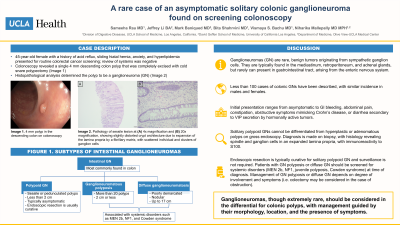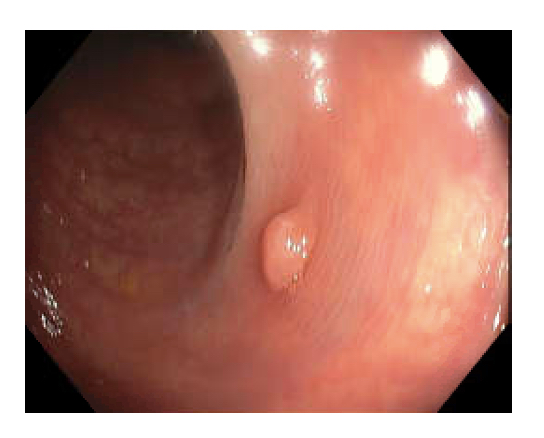Monday Poster Session
Category: Colon
P2041 - A Rare Case of an Asymptomatic Solitary Colonic Ganglioneuroma Found on Screening Colonoscopy
Monday, October 28, 2024
10:30 AM - 4:00 PM ET
Location: Exhibit Hall E

Has Audio

Sameeha Rau, MD
David Geffen School of Medicine at UCLA
Los Angeles, CA
Presenting Author(s)
Sameeha Rau, MD1, Jeffrey Li, BA1, Mark Baniqued, MD1, Bita Shahrvini, MD1, Vismaya S.. Bachu, MD2, Niharika Mallepally, MD, MPH1
1David Geffen School of Medicine at UCLA, Los Angeles, CA; 2University of California Los Angeles Medical Center, Los Angeles, CA
Introduction: Ganglioneuromas (GN) are rare, benign tumors originating from sympathetic ganglion cells. They are typically found in the mediastinum, retroperitoneum, and adrenal glands but can present in the gastrointestinal tract, arising from the enteric nervous system. Less than 100 cases of colonic GNs have been described. We present a case of this rare tumor detected on routine colonoscopy in an asymptomatic individual.
Case Description/Methods: A 45-year-old female with a history of acid reflux, sliding hiatal hernia, anxiety, and hyperlipidemia presented for routine colorectal cancer screening. Her review of systems was negative. Colonoscopy revealed a single 4 mm descending colon polyp that was completely excised with cold snare polypectomy (Image 1). Histopathological analysis determined the polyp to be a GN, identified with positive neurofilament staining.
Discussion: Intestinal GNs are most commonly found in the colon and can be categorized into three groups: polypoid GN (sessile or pedunculated polyps, < 2 cm), ganglioneuromatous polyposis ( > 20 polyps, ≤ 2 cm), and diffuse ganglioneuromatosis (poorly demarcated, nodular, up to 17 cm). Clinical symptoms depend on the size, number, and location of the GN(s). Previous case reports have described initial patient presentation with occult GI bleeding, abdominal pain, constipation, obstructive symptoms mimicking Crohn’s disease, and even diarrhea secondary to vasoactive intestinal peptide secretion by hormonally active tumors. As in our case, solitary polypoid GNs are typically asymptomatic and cannot be differentiated from hyperplastic or adenomatous polyps on gross endoscopy. Histology reveals spindle and ganglion cells in an expanded lamina propria. For solitary polypoid GNs, endoscopic polypectomy is curative and surveillance is usually not required, though a prior case report described a possible association between polypoid GNs and colorectal adenocarcinoma. In contrast, GN polyposis and diffuse GN are associated with several systemic disorders, such as multiple endocrine neoplasia 2b, neurofibromatosis type 1, and Cowden syndrome, which require screening for these conditions at the time of diagnosis. In such cases, colectomy may be considered based on the degree of involvement and associated symptoms (i.e. obstruction). GNs, though extremely rare, should be considered in the differential for colonic polyps, with management guided by their location, presence of symptoms, and histologic subtype.

Disclosures:
Sameeha Rau, MD1, Jeffrey Li, BA1, Mark Baniqued, MD1, Bita Shahrvini, MD1, Vismaya S.. Bachu, MD2, Niharika Mallepally, MD, MPH1. P2041 - A Rare Case of an Asymptomatic Solitary Colonic Ganglioneuroma Found on Screening Colonoscopy, ACG 2024 Annual Scientific Meeting Abstracts. Philadelphia, PA: American College of Gastroenterology.
1David Geffen School of Medicine at UCLA, Los Angeles, CA; 2University of California Los Angeles Medical Center, Los Angeles, CA
Introduction: Ganglioneuromas (GN) are rare, benign tumors originating from sympathetic ganglion cells. They are typically found in the mediastinum, retroperitoneum, and adrenal glands but can present in the gastrointestinal tract, arising from the enteric nervous system. Less than 100 cases of colonic GNs have been described. We present a case of this rare tumor detected on routine colonoscopy in an asymptomatic individual.
Case Description/Methods: A 45-year-old female with a history of acid reflux, sliding hiatal hernia, anxiety, and hyperlipidemia presented for routine colorectal cancer screening. Her review of systems was negative. Colonoscopy revealed a single 4 mm descending colon polyp that was completely excised with cold snare polypectomy (Image 1). Histopathological analysis determined the polyp to be a GN, identified with positive neurofilament staining.
Discussion: Intestinal GNs are most commonly found in the colon and can be categorized into three groups: polypoid GN (sessile or pedunculated polyps, < 2 cm), ganglioneuromatous polyposis ( > 20 polyps, ≤ 2 cm), and diffuse ganglioneuromatosis (poorly demarcated, nodular, up to 17 cm). Clinical symptoms depend on the size, number, and location of the GN(s). Previous case reports have described initial patient presentation with occult GI bleeding, abdominal pain, constipation, obstructive symptoms mimicking Crohn’s disease, and even diarrhea secondary to vasoactive intestinal peptide secretion by hormonally active tumors. As in our case, solitary polypoid GNs are typically asymptomatic and cannot be differentiated from hyperplastic or adenomatous polyps on gross endoscopy. Histology reveals spindle and ganglion cells in an expanded lamina propria. For solitary polypoid GNs, endoscopic polypectomy is curative and surveillance is usually not required, though a prior case report described a possible association between polypoid GNs and colorectal adenocarcinoma. In contrast, GN polyposis and diffuse GN are associated with several systemic disorders, such as multiple endocrine neoplasia 2b, neurofibromatosis type 1, and Cowden syndrome, which require screening for these conditions at the time of diagnosis. In such cases, colectomy may be considered based on the degree of involvement and associated symptoms (i.e. obstruction). GNs, though extremely rare, should be considered in the differential for colonic polyps, with management guided by their location, presence of symptoms, and histologic subtype.

Figure: Image 1: 4 mm polyp in the descending colon on colonoscopy
Disclosures:
Sameeha Rau indicated no relevant financial relationships.
Jeffrey Li indicated no relevant financial relationships.
Mark Baniqued indicated no relevant financial relationships.
Bita Shahrvini indicated no relevant financial relationships.
Vismaya Bachu indicated no relevant financial relationships.
Niharika Mallepally indicated no relevant financial relationships.
Sameeha Rau, MD1, Jeffrey Li, BA1, Mark Baniqued, MD1, Bita Shahrvini, MD1, Vismaya S.. Bachu, MD2, Niharika Mallepally, MD, MPH1. P2041 - A Rare Case of an Asymptomatic Solitary Colonic Ganglioneuroma Found on Screening Colonoscopy, ACG 2024 Annual Scientific Meeting Abstracts. Philadelphia, PA: American College of Gastroenterology.
